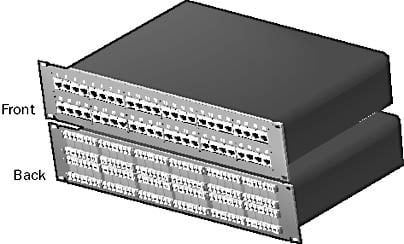Definition of Patch Panel in Network Encyclopedia.
What is Patch Panel (in networking)?
Patch Panel is a rack-mounted panel with a series of connectors that provides a branching-out point for network cabling to leave the wiring closet and make horizontal runs to wall plates in the work areas.

Patch panels are usually standard 19-inch-wide panels for mounting in equipment racks in wiring closets. They typically contain between 16 and 96 ports for connecting to hubs and switches using patch cables. Patch panels themselves cannot be used to network computers; they are mainly used to organize wiring and to avoid “spaghetti.” The horizontal cables running from the wiring closet to the wall plates are usually connected to the back of the patch panel, while the patch cords connecting to the hubs and switches plug into the front of the patch panel. The back of the patch panel is a form of punchdown block – wires are not soldered but punched down using a sharp tool called a punchdown block tool.
Patch Panel or Passive Hub
Another name for a patch panel is passive hub. A patch panel is a hub only in the sense that it is a physical device in which wires are concentrated, but it cannot be used to network computers. All true hubs used in networking are active hubs, which are powered devices that regenerate signals coming into one port for transmission through other ports on the hub. The term “passive hub” is an older term that is not generally used today.
In telephony applications, the termination point for twisted-pair wiring is usually called a punchdown block instead of a patch panel.
There are a few things you should be aware of when selecting patch panels:
- Be sure that your patch panels are category 5–approved if you plan to upgrade your network.
- Do not remove excessive amounts of cable jacket when you terminate category 5 cables to terminal blocks.
- Purchase patch panels with built-in surge protection to protect expensive Ethernet switches.
Front-access patch panels are easiest to install in cramped conditions. You can use hinged or folding patch panels as a convenient alternative to full-size, rack-mounted patch panels. Modular patch panels allow the greatest flexibility of configuration. Use cable managers to organize and support cables connected to patch panels.